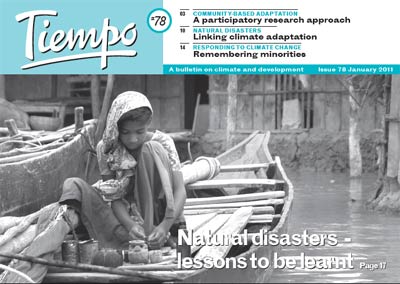Tiempo Climate Cyberlibrary
Tiempo Archive
- Tiempo archive
- Complete issues
- Selected articles
- Cartoons
- Climate treaty
- Latest news
- Secretariat
- National reports
- IPCC
About the Cyberlibrary
The Tiempo Climate Cyberlibrary was developed by Mick Kelly and Sarah Granich on behalf of the Stockholm Environment Institute and the International Institute for Environment and Development, with sponsorship from the Swedish International Development Cooperation Agency.
While every effort is made to ensure that information on this site, and on other sites that are referenced here, is accurate, no liability for loss or damage resulting from use of this information can be accepted.
Final Issue - January 2011

Available in Adobe Acrobat (PDF) format:
Right click on the link to download the file and read off-line. This may prove more reliable than reading the file within your browser.
To view the pdf file, you will need Adobe® Reader®.
The final issue of the printed bulletin was published in January 2011.
Issues 51 onwards
Issues 51 onwards of Tiempo are available in Adobe Acrobat (PDF) format:
- Issue 77, low resolution (0.8MB)
- Issue 77, high resolution (4.4MB)
- Issue 76, low resolution (0.9MB)
- Issue 76, high resolution (2.9MB)
- Issue 75, low resolution (0.8MB)
- Issue 75, high resolution (6.9MB)
- Issue 74, low resolution (0.8MB)
- Issue 74, high resolution (2.8MB)
- Issue 73, low resolution (0.8MB)
- Issue 73, high resolution (3.5MB)
- Issue 72, low resolution (0.9MB)
- Issue 72, high resolution (5.3MB)
- Issue 71, low resolution (1.6MB)
- Issue 71, high resolution (4.7MB)
- Issue 70, low resolution (1.7MB)
- Issue 70, high resolution (2.6MB)
- Issue 69, low resolution (1.7MB)
- Issue 69, high resolution (4.7MB)
- Issue 68, low resolution (1.6MB)
- Issue 68, high resolution (7.0MB)
- Issue 67, low resolution (1.6MB)
- Issue 67, high resolution (3.1MB)
- Issue 66, low resolution (1.2MB)
- Issue 66, high resolution (4.4MB)
- Issue 65, low resolution (1.1MB)
- Issue 65, high resolution (4.1MB)
- Issue 64, low resolution (1.6MB)
- Issue 64, high resolution (3.8MB)
- Issue 63, low resolution (0.9MB)
- Issue 63, high resolution (3.2MB)
- Issue 62, low resolution (0.9MB)
- Issue 62, high resolution (6.0MB)
- Issue 61, low resolution (0.8MB)
- Issue 61, high resolution (5MB)
- Issue 60, low resolution (0.9MB)
- Issue 60, high resolution (4.6MB)
- Issue 59, low resolution (0.9MB)
- Issue 59, high resolution (3.0MB)
- Issue 58, low resolution (0.8MB)
- Issue 58, high resolution (2.6MB)
- Issue 57, low resolution (0.9MB)
- Issue 57, high resolution (9.2MB)
- Issue 56, low resolution (0.7MB)
- Issue 56, high resolution (4.6MB)
- Issue 55, low resolution (1MB)
- Issue 55, high resolution (3.3MB)
- Issue 54, low resolution (0.6MB)
- Issue 54, high resolution (2.3MB)
- Issue 53, low resolution (0.6MB)
- Issue 53, high resolution (3MB)
- Issue 52, low resolution (0.8MB)
- Issue 52, high resolution (3MB)
- Issue 51, low resolution (0.7MB)
- Issue 51, high resolution (3.4MB)
Issues 24 to 50
Issues 24 to 50 of Tiempo are available in HTML format:
- Issue 50 - December 2003
- Issue 49 - September 2003
- Issue 48 - June 2003
- Issue 47 - March 2003
- Issue 46 - January 2003
- Issue 44/45 - September 2002
- Issue 43 - March 2002
- Issue 42 - December 2001
- Issue 40/41 - September 2001
- Issue 38/39 - June 2001
- Issue 36/37 - September 2000
- Issue 35 - March 2000
- Issue 34 - December 1999
- Issue 33 - September 1999
- Issue 32 - June 1999
- Issue 31 - March 1999
- Issue 30 - December 1998
- Issue 29 - September 1998
- Issue 28 - June 1998
- Issue 27 - March 1998
- Issue 26 - December 1997
- Issue 25 - September 1997
Bright Ideas

General Electric plans to cut solar installation costs by half

Project 90 by 2030 supports South African school children and managers reduce their carbon footprint through its Club programme

Bath & North East Somerset Council in the United Kingdom has installed smart LED carriageway lighting that automatically adjusts to light and traffic levels

The United States National Oceanic and Atmospheric Administration and the American Public Gardens Association are mounting an educational exhibit at Longwood Gardens showing the link between temperature and planting zones

The energy-efficient Crowne Plaza Copenhagen Towers hotel is powered by renewable and sustainable sources, including integrated solar photovoltaics and guest-powered bicycles
El Hierro, one of the Canary Islands, plans to generate 80 per cent of its energy from renewable sources

The green roof on the Remarkables Primary School in New Zealand reduces stormwater runoff, provides insulation and doubles as an outdoor classroom

The Weather Info for All project aims to roll out up to five thousand automatic weather observation stations throughout Africa

SolSource turns its own waste heat into electricity or stores it in thermal fabrics, harnessing the sun's energy for cooking and electricity for low-income families

The Wave House uses vegetation for its architectural and environmental qualities, and especially in terms of thermal insulation

The Mbale compost-processing plant in Uganda produces cheaper fertilizer and reduces greenhouse gas emissions

At Casa Grande, Frito-Lay has reduced energy consumption by nearly a fifth since 2006 by, amongst other things, installing a heat recovery system to preheat cooking oil
<
Updated: May 15th 2015